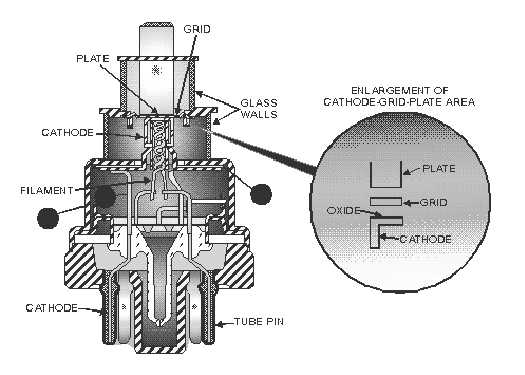2-13
A typical planar tube is depicted in figure 2-13. Notice that the tube elements are mounted close to
each other and are parallel to one another. The oxide coating of the cathode is applied to the top surface
only. Therefore, the emitting surface of the cathode is parallel to the plate and the grid.
Figure 2-13.—Internal structure of a typical planar tube.
The plate of the tube consists of a cylindrical stud. This stud-plate construction has two purposes. Its
flat lower surface serves as a parallel plate, and its external upper end serves as the external-plate
connection from the tube to the circuit.
Because of its construction, the planar tube cannot use the ladder-type grid, with which you are
familiar. Instead, the grid, formed into a circle, is composed of a wire mesh similar to that of a common
screen door.
The cathode structure is manufactured in two parts. Point A of figure 2-13 is the metallic shell of the
tube and is used to couple (or connect) unwanted radio frequency signals from the cathode to ground.
This connection is not, however, a direct coupling. The wafer at point C of figure 2-13 is composed of
mica, which serves as a dielectric. The lower extension of the cathode serves as one plate of the capacitor,
while the other plate is formed from the flattened upper portion of the cathode connector ring. The
cathode has a direct connection to the tube pin through the connector labeled point B. You might think
that this is a rather complicated method to connect the cathode to a circuit, but it serves a purpose. At high
frequencies, the wiring of a circuit can pick up radio frequency signals and retransmit them. If the wiring
involved happens to be the wiring used to supply dc voltages to the circuit, all the tubes in the circuit will
receive the signal. The result will be massive distortion throughout the circuit.
The problem can be eliminated by isolating the dc and radio frequency circuits from each other. In
planar tubes, this is fairly simple. The point A ring is grounded. Any rf signals that the cathode may pick
up through tube conduction are grounded or shorted to ground through the capacitive coupling with the
point A shell. In other words, the point A shell (capacitive ground) serves the same function as the bypass

